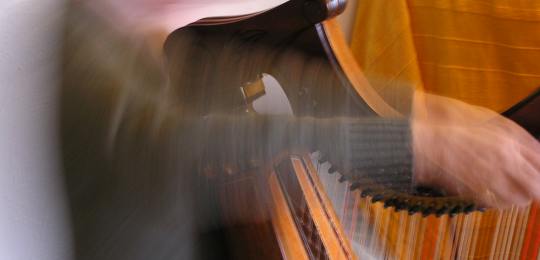|
I have written it before, and I'll write it again: Llio Rhydderch is a national treasure. She's Welsh, she plays the triple-harp, she lives on the island of Ynys Môn (Anglesey) off the North Wales coast, and she's in a line of harpist-composers going back through the centuries. A very fine composer and improviser, also creating variations on traditional melodies, in terms of her skill, stature and importance she's the present-day equivalent of the great Irish harpers such as Carolan.
So – the triple harp. It's an elegant high-headed harp, with (these days) nylon strings, bearing three parallel rows of strings; the outer two are tuned diatonically, the middle one, reached through the outside ones, provides the semitones. It originated in 16th-century Italy, but has fallen out of use everywhere except Wales, so has come to be regarded as the Welsh harp, though only a relatively few Welsh harpists play it; others have opted for the huge, gilt-ornamented, pedal-equipped classical concert harp.
The three-row string arrangement, while tricky to play, prompts ideas and possibilities for harmony and variation that don't spring as naturally from single-strung harps, and there's no one to touch Rhydderch for her creativity and skill in utilising that. Most of her albums are largely of her own compositions, but for this, her sixth, she plays and develops melodies from tradition and the musicians of centuries past. As she writes (in Welsh and English):
“These melodies reflect the different periods of my life. Things I heard as a child at home had a strong influence on me. I became familiar with a large number of harp tunes, ballads and folk songs that became the foundation of my music. Also, I learned Sol-fa from my mother, and from my father I learned by ear the art of cynghanedd – the strict metre. Time spent searching old manuscripts in the National Library of Wales, Aberystwyth and in the archives of Bangor University was an important inspiration to later and continues to be this day. On reflection, it is probable that the influence of musicians from far and near, especially those from foreign lands with whom I have toured and recorded, is evident in my music”.
The album is a gem, a glorious thing of crisp cascading notes in perfectly flowing musical structures; she has wonderful, subtle, communicative judgement of both rhythm and legato freedom, and her interpretations and variations bring these tunes to new life. (Its title is both the name of a geological fault-line running across Anglesey and the title of the first melody, from a version in the 1808 tune-book of fiddler Robert Thomas, and 'bach' is also a term of endearment).
Recorded on Anglesey, the production quality is exquisite, sparkling and airy. Like her others, this one was produced by Ceri Rhys Matthews, who has long championed Rhydderch, ever since the days when she seemed to be being shamefully ignored by the Welsh musical establishment. (The award to her by Bangor University of an Honorary Fellowship for services to music, “recognised as the foremost exponent of the Welsh triple harp” shows how that has changed). - Andrew Cronshaw
Photo by and ©2020; Andrew Cronshaw
|
